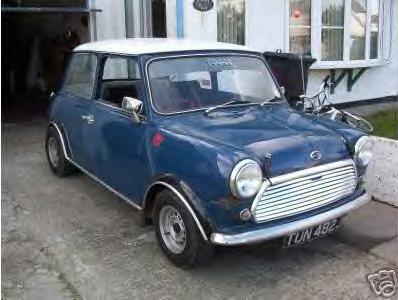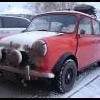Have just sold the carb off my new mini so have some money to start buying some rust treatment and paint. I am going to use dinitrol rust treatment as I'm told its the only one that works. The only place I have found that sells it is 'Frost Restorers Equipment' so I will be ordering from them anyway.
Basically I will need some sort of seam sealer and they sell various so am wondering whether anyone can recommend a good one and tell me if its worth buying some from them?? Whats this one like?
They also sell 'WELD-THU' primer which is sposed to provide good corrosion protection and good conductivity for welding. Does any one have any experience of it and whether it works?? Would it just burn off when welding??

Weld thru paint/seam sealer
Started by
adam c
, May 24 2004 07:26 PM
7 replies to this topic
#1

Posted 24 May 2004 - 07:26 PM
#2

Posted 24 May 2004 - 09:49 PM
The zinc weld thru primer is a must ,we had to use it for the ford rust warenty on all panelwork done at the main dealers i worked at , and i can tell you it works :grin: and it is heat resistant so will not burn off even at welding temps.
The seam sealer we had to use was a polyurathane based sealer ,, and it worked verry well but you must primer all bare metal (with self-etch primer) before applying , or it just peels .
and after the repair is done , apply lots of waxoyl into the hollow sections and all seams .
ford put a lot of development into finding rust proof repair methods as they offer a 6 year warrenty :grin:
The seam sealer we had to use was a polyurathane based sealer ,, and it worked verry well but you must primer all bare metal (with self-etch primer) before applying , or it just peels .
and after the repair is done , apply lots of waxoyl into the hollow sections and all seams .
ford put a lot of development into finding rust proof repair methods as they offer a 6 year warrenty :grin:
#3

Posted 25 May 2004 - 07:04 AM
Thanks very much mate. Have already got a load of etch primer ready for the bodywork, but wouldn't have thought of putting it behind the seam sealer so thanks very much :grin:
Will order a couple of cans of the paint now...
Will order a couple of cans of the paint now...
#4

Posted 25 May 2004 - 12:41 PM
Hi. I'll offer the following comments from my experience. Buy panels with the anodic (or is it cathodic?) primer (Rover, M-Machine, Heritage). This tough primer only needs scuffing up for adhesion of your primer and top coat. IF the primer on your replacement panels can be softened or removed with lacquer thinner (cellulose thinner)... take it all off to bare metal and re-treat/prime with quality materials. DO NOT leave any primer (Rover or cheap stuff) on the edges you will be welding. Strip the edges to bare metal and use the weld-thru primer.
Weld through primers are great. They do everything their name implies and they don't interfere with the welding process. The primer used by Heritage will REALLY mess us your welds if you are TIG welding.
I have only used brushable seam sealers, however they are also available in heavy spray from some sources. For best results allow it at least 24 hours to dry (and shrink) before top coating. The can will say "paintable in X-minutes". This is true, but if anyone will see the seam, wait to paint. The slow shrinkage of the seam sealer will result in cracks in the top coat if painted too early. You can also consider doing lead work to fill seams like on the wings and scuttle if you want something that will never shrink and crack. This will be next to impossible on old panels with any rust.
Weld through primers are great. They do everything their name implies and they don't interfere with the welding process. The primer used by Heritage will REALLY mess us your welds if you are TIG welding.
I have only used brushable seam sealers, however they are also available in heavy spray from some sources. For best results allow it at least 24 hours to dry (and shrink) before top coating. The can will say "paintable in X-minutes". This is true, but if anyone will see the seam, wait to paint. The slow shrinkage of the seam sealer will result in cracks in the top coat if painted too early. You can also consider doing lead work to fill seams like on the wings and scuttle if you want something that will never shrink and crack. This will be next to impossible on old panels with any rust.
#5

Posted 26 May 2004 - 06:03 AM
WOW, lead , i havent used that in a while ...
#6

Posted 26 May 2004 - 02:17 PM
I've read loads about how to use lead but it seemed like it would be pretty tricky and I'm a lazy git and would want to use me sander to sand it down - not recommended!!
Wouldn't it look quite odd with no seams on a mini (I presume you fill it till its smooth). Any one got any pics of a mini thats been lead loaded?? I like the idea as new panels, good seam sealer, weld thru primer and lead in the seams would make a pretty rust proof car which would be great.
If you guys think its worth it have you got any tips?? Would it take me hours to master it?? I know the basic process from books so just some tips would be great :grin: ..
Oh and cheers again guys for some sound advice :cool:
Wouldn't it look quite odd with no seams on a mini (I presume you fill it till its smooth). Any one got any pics of a mini thats been lead loaded?? I like the idea as new panels, good seam sealer, weld thru primer and lead in the seams would make a pretty rust proof car which would be great.
If you guys think its worth it have you got any tips?? Would it take me hours to master it?? I know the basic process from books so just some tips would be great :grin: ..
Oh and cheers again guys for some sound advice :cool:
#7

Posted 26 May 2004 - 02:27 PM
the seam along the valence and the wings and the scuttle and the wings on mine will be gone when i'm done too...I am using a liquid steel compound to fill it then I'm going to do the final filling with an aluminum body filler so rust can never get to it...this is because aluminum boddy fill willnot absorb mousture.
Sorry if that didn't make sense to anyone but i know what i mean. :tongue:
Al
Sorry if that didn't make sense to anyone but i know what i mean. :tongue:
Al
#8

Posted 26 May 2004 - 04:52 PM
My "leading" techniques aren't proper because I don't have an oxy-acetylene torch and/or the proper paddles to smooth it out. Basically you start with clean, bare metal to which you apply what is called "tinning butter". It's a mixture of lead powder and flux that quickly wicks out over the metal surface when heated with a soft flame. In the case of wings and scuttles, it would be best to just tin the radii where the two panels meet. You don't want the lead all down the flange because you'll spotweld there. Pre-tinning the radii prior to spot welding the new panels in is desirable because you can thoroughly clean off the flux before final lead work and subsequent painting. Once the tinned panels are adjacent to each other you heat a small area with a soft flame and flow 60/40 lead/tin solder on the area you want to coat. You use a hardwood paddle dipped in tallow to smooth out the molten/soft lead trying to leave as few high-spots as possible. Filing is preferred over sanding for health reasons. Once the rough filing has been done you can follow up with limited sanding. Pin holes in the coat and shallow dips can be filled with "bondo" type fillers. The basics of this technique are shown in the Porter/Haynes book on DIY Mini restoration.
The leading process can be used to hide the seams if that's what you're after. However, it doesn't have to hide the seams. You can use the surface tension of the lead to produce nice, gentle fillets between the panels... keeping the traditional look. The "filled" fillers like Al was mentioning are generally stronger and have better adhesion than regular "bondo". Some are available with fiberglass filling for good flexure strength. Lead work is a labor of love and requires a lot of preparation and clean up. Plastic fillers are much easier to use but by themselves aren't suitable for the seams between the scuttle and wing. The joint there flexes more than you'd imagine. Regular seam sealer properly applied to a well prepared joint will last for years and retain the traditional look.
The leading process can be used to hide the seams if that's what you're after. However, it doesn't have to hide the seams. You can use the surface tension of the lead to produce nice, gentle fillets between the panels... keeping the traditional look. The "filled" fillers like Al was mentioning are generally stronger and have better adhesion than regular "bondo". Some are available with fiberglass filling for good flexure strength. Lead work is a labor of love and requires a lot of preparation and clean up. Plastic fillers are much easier to use but by themselves aren't suitable for the seams between the scuttle and wing. The joint there flexes more than you'd imagine. Regular seam sealer properly applied to a well prepared joint will last for years and retain the traditional look.
1 user(s) are reading this topic
0 members, 1 guests, 0 anonymous users
















